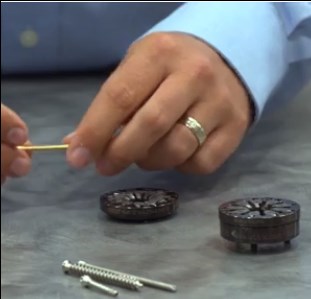VIDEOS: Tips for Screw Making on Swiss-Type Machines
Here’s a three-part video series focused on Swiss screw making to help explain the benefits of thread whirling, back turning and broaching while taking into consideration CAM programming, tooling and machine specifications.
#basics

If a high percentage of parts in a shop have threaded profiles, thread whirling is worth considering, as opposed to single-point threading.
Today’s range of CNC Swiss-type lathes have more capabilities than ever before. They are becoming more prevalent in the market, as more companies are discovering the benefits these sliders can bring to their organizations.
A common application is producing screws, often for the medical industry. These can range from bone screws to orthopedic implants. The fact that these machines can achieve tight tolerances makes them well suited to screw making. As cutting occurs close to the guide bushing, the material being cut is better supported and basic mechanics tells us that better support means less deflection. Stationary tools and a sliding headstock mean that parts with a larger length-to-diameter ratio can be produced.
Featured Content
Increased Throughput
But it’s not solely precision alone that makes these CNC machines appealing. With the onset of smaller lot sizes and shorter deadlines for micro-components, there’s more of a need to increase throughput. Due to the multitasking nature of Swiss machines, process synchronization is certainly one way to achieve productivity gains. The option of either synchronizing multiple tool posts on the same spindle (such as pinch milling or follow turning), or on opposing spindles is a great way to lower cycle times and increase throughput.
Tooling
Another is influenced by tooling. There are often numerous ways to machine a screw on a Swiss machine. Take for example threading; if a high percentage of parts in a shop have threaded profiles, thread whirling is worth considering, as opposed to single-point threading—whirling inserts and holders, rather than a dedicated machine. It may well be more cost-effective given the batch size to invest more money upfront on this type of tooling for a higher return on investment. This is achievable through the benefits typically associated with thread whirling:
- Faster machining of deeper thread forms like Acme
- Prolonged tool life due to the increased strength on the cutting edge of a whirling insert
- More productivity by removing the need for multiple passes
- Reduced deflection through improved rigidity and support, helping to machine longer threads
The same consideration can be applied to turned profiles. The objective is to achieve a finished surface that conforms to the design specification by only using a single pass. This can be a challenge when using conventionally angled turning inserts to turn a shape like a screw head, as there can be issues with clearance when machining past the large diameter. This is where back turning tools come into play with their unique geometry and cutting characteristics.
Back turning can not only provide more clearance when machining past a larger diameter, but can also introduce other benefits to the process. When using wiper geometry, the front side of the tool essentially cuts and the backside burnishes. This adds strength to the leading edge and leaves a high surface finish, removing the need for secondary operations.
Polygonal Shapes
One of the final steps of Swiss screw machining is cutting an often polygonal shaped internal drive feature on the back of the screw head. This drive feature is what later houses a hex or Allen wrench to tighten the screw. To avoid any internal radii in the corners of the drive feature (sometimes seen with polar milling), a common technique used is broaching. Rotary or wobble broaching is an efficient method for cutting these types of polygonal shapes. The cutter and spindle are synchronized, allowing for a single operation to create the finished shape. Other types of broaching include index punch or static.
Autodesk, Inc., Genevieve Swiss Industries, Inc. and Tsugami/REM Sales LLC have teamed up in this three-part collaborative video series focused on screw making to help explain the benefits of thread whirling, back turning and broaching while taking into consideration CAM programming, tooling and machine specifications. The first video (above) shows thread whirling operations.
Here is the second video about broaching:
Here is the third video about back turning:
RELATED CONTENT
-
Plateau Honing Improves Finish and Lubrication Control
Plateau honing is a process that improves cylinder wall surface finish by removing tiny peaks of torn or folded material and increasing bearing area.
-
5 Process Security Tips for Parting Off
Here are five rules of thumb from Scott Lewis, a product and application specialist at Sandvik Coromant, to optimize the parting off process, and as a result, maximize tool and insert life.
-
Thread Whirling Basics
The rapidly increasing demand for high-value threaded parts with exceptionally high length-to-diameter ratios has created a lot of interest in thread whirling technology among American shops and manufacturers.





